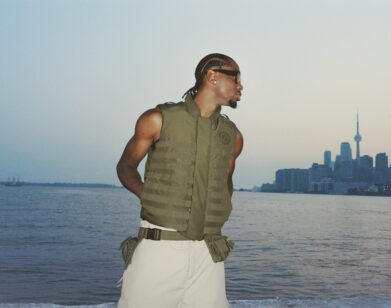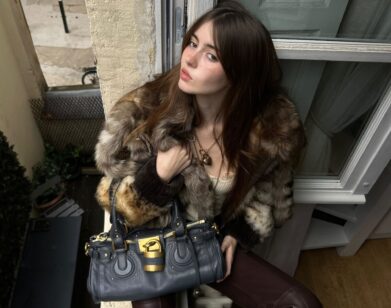Menswear Through the Looking Glass
In the second installment of its “Vestirsi Da Uomo” (Dress Like A Man) fashion performance series, Florence’s Pitti Uomo gave carte blanche last Thursday to legendary French art director Marc Ascoli, who took over the immense Villa Fayard, the new site of the city’s Polimoda fashion school, for a series of tableaux vivants. From one ornate and cavernous room to the next, these fantastic, disjointed scenes presented a dreamy look at contemporary menswear, featuring pieces selected from the fall collections of an international cast of brands—Engineered Garments, Folk, Black Fleece by Brooks Brothers, Yuketen, Barbour, Cruciani, and Henro, to name a few—defiantly, radically, deliriously “accessorized,” almost beyond recognition, by students in a Polimoda master class, who have contributed to the project since last October.
It looked like Ascoli had decided to carry on where David Lynch’s Inland Empire and Rabbits series left off, or invite his audience to follow him and Alice in Wonderland down the rabbit hole to see through fashion beyond the looking glass.
Men in giant rabbit heads—dressed in a flamboyant mix of neo-19th century country squire classics and fantasy rainbow crochet with elaborate floral headgear and the odd skirt thrown in here and there—paced back and forth around a table, or engaged in a pas de deux with a ghostly nightmare Countess de Castiglione, a 19th-century courtesan who lived in Florence before she became the mistress of Emperor Napoleon in Paris (interpreted by Raphaelle Boitel of Club Silencio). Two sweaters made love in an old armoire (animated by members of the Compagnia Dromosfisti circus troupe), while nearby, the eerie, angelic voice of new French singer Owlle (winner of 2011s Inrocks Lab contest) and her Omnichord, a strange little console that sounds like a cross between a harp and a synthesizer, surrounded by a pool of light bulbs, mixed with snippets of music from Pina Bausch ballets and other great bits from sound artist Frédéric Sanchez. After a while in the villa, Pitti’s professional fashion crowd began to forget about the business of clothes.
Marc Ascoli, has over the past three decades, has turned out seminal image books and campaigns for Yohji Yamamoto, Jil Sander, Chloé under Phoebe Philo, Martine Sitbon and many others. Along the way, he has also launched the careers of photographers Nick Knight, Max Vadukul, Koto Bolofo, Javier Valhonrat, Craig McDean, Liz Collins, and Mert Alas and Marcus Piggot. He’s also done breakthrough work with Paolo Roversi, David Sims, Peter Lindbergh, and Sølve Sundsbø, and shed the light on graphics talents Peter Savile and M/M’s Mathias Augustyniak and Michaël Amzalag.
And so this race into space was quite a surprise coming from someone who is such a master of fashion’s reality-based “what’s next” system. “The thing about Pitti is that they let you do exactly what you want,” says Ascoli, who is currently working on a book for Rizzoli about the past 60 years of the French fashion house Chloé. “The only stipulation they gave me was to work with clothes from a selection of brands exhibiting at the fair. Everything today has become so slick and predigested. I wanted to escape the impeccable, relentless perfection of all that and touch something romantic, and poetic. I could have done a video, or a photo series, but that would have been just another fashion spread. Instead I wanted to put the clothes in an abnormal situation, mix nightmares and dreams like Lynch, Jean Cocteau or in certain French films like Claude Chabrol’s Les Biches (Bad Girls, 1968). When I met Polimoda’s new director Linda Loppa and Patrick De Muyinck with their students at Villa Favard, which is the most beautiful place in the world for a school, I knew I had found what I was looking for.”







